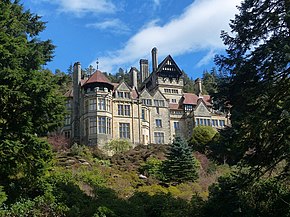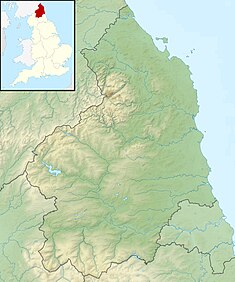| Cragside | |
|---|---|
 | |
| Type | House |
| Location | Rothbury, Northumberland, United Kingdom |
| Coordinates | 55°18′49″N 1°53′07″W / 55.3136°N 1.8853°W |
| Built | 1869–1895 |
| Built for | William Armstrong, Baron Armstrong of Cragside |
| Architect | Richard Norman Shaw |
| Architectural style(s) | Tudor Revival |
| Governing body | National Trust |
Listed Building – Grade I | |
| Official name | Cragside |
| Designated | 21 October 1953 |
| Reference no. | 1042076 |
Listed Building – Grade II* | |
| Official name | Iron Bridge Across the Debdon |
| Designated | 25 August 1987 |
| Reference no. | 1042033 |
Listed Building – Grade II* | |
| Official name | Clock Tower 110 Metres North East of Cragside Park House |
| Designated | 22 December 1981 |
| Reference no. | 1354750 |
| Official name | Cragside park and gardens |
| Designated | 1 January 1985 |
| Reference no. | 1001046 |
| Grade | I |
Cragside is a Victorian Tudor Revival country house near the town of Rothbury in Northumberland, England. It was the home of William Armstrong, 1st Baron Armstrong, founder of the Armstrong Whitworth armaments firm. An industrial magnate, scientist, philanthropist and inventor of the hydraulic crane and the Armstrong gun, Armstrong also displayed his inventiveness in the domestic sphere, making Cragside the first house in the world to be lit using hydroelectric power. The estate was technologically advanced; the architect of the house, Richard Norman Shaw, wrote that it was equipped with "wonderful hydraulic machines that do all sorts of things".[2] In the grounds, Armstrong built dams and lakes to power a sawmill, a water-powered laundry, early versions of a dishwasher and a dumb waiter, a hydraulic lift and a hydroelectric rotisserie. In 1887, Armstrong was raised to the peerage, the first engineer or scientist to be ennobled, and became Baron Armstrong of Cragside.
The original building consisted of a small shooting lodge which Armstrong built between 1862 and 1864. In 1869, he employed the architect Richard Norman Shaw to enlarge the site, and in two phases of work between 1869 and 1882, they transformed the house into a northern Neuschwanstein. The result was described by the architect and writer Harry Stuart Goodhart-Rendel as "one of the most dramatic compositions in all architecture".[3] Armstrong filled the house with a significant art collection; he and his wife were patrons of many 19th-century British artists. Cragside became an integral part of Armstrong's commercial operations: honoured guests under Armstrong's roof, including the Shah of Persia, the King of Siam and two future Prime Ministers of Japan, were also customers for his commercial undertakings.
Following Armstrong's death in 1900, his heirs struggled to maintain the house and estate. In 1910, the best of Armstrong's art collection was sold off, and by the 1970s, in an attempt to meet inheritance tax, plans were submitted for large-scale residential development of the estate. In 1971 the National Trust asked the architectural historian Mark Girouard to compile a gazetteer of the most important Victorian houses in Britain which the Trust should seek to save should they ever be sold. Girouard placed Cragside at the top of the list; in 1977, the house was acquired by the Trust with the aid of a grant from the National Land Fund. A Grade I listed building since 1953, Cragside has been open to the public since 1979.
- ^ Girouard 1979, p. 307.
- ^ Saint 1992, p. 17.
- ^ Ferriday 1963, p. 70.
